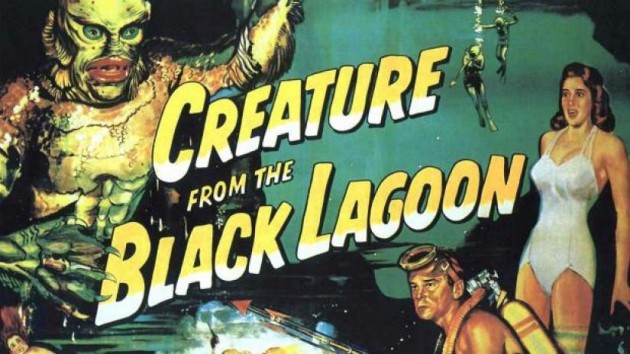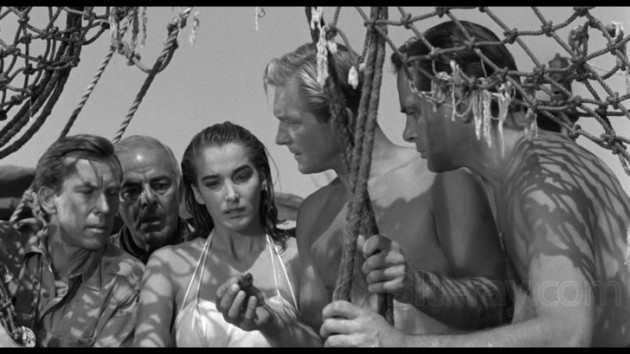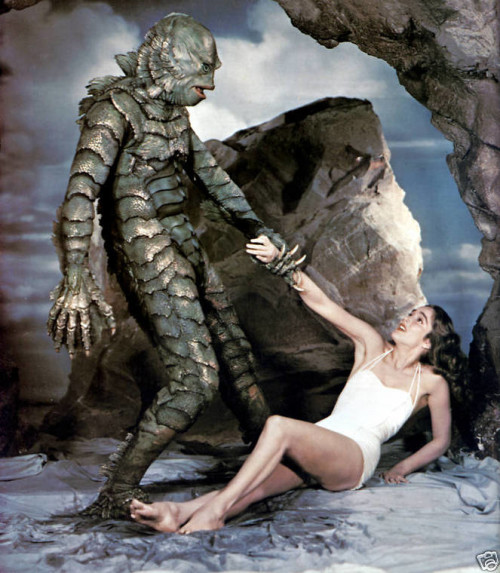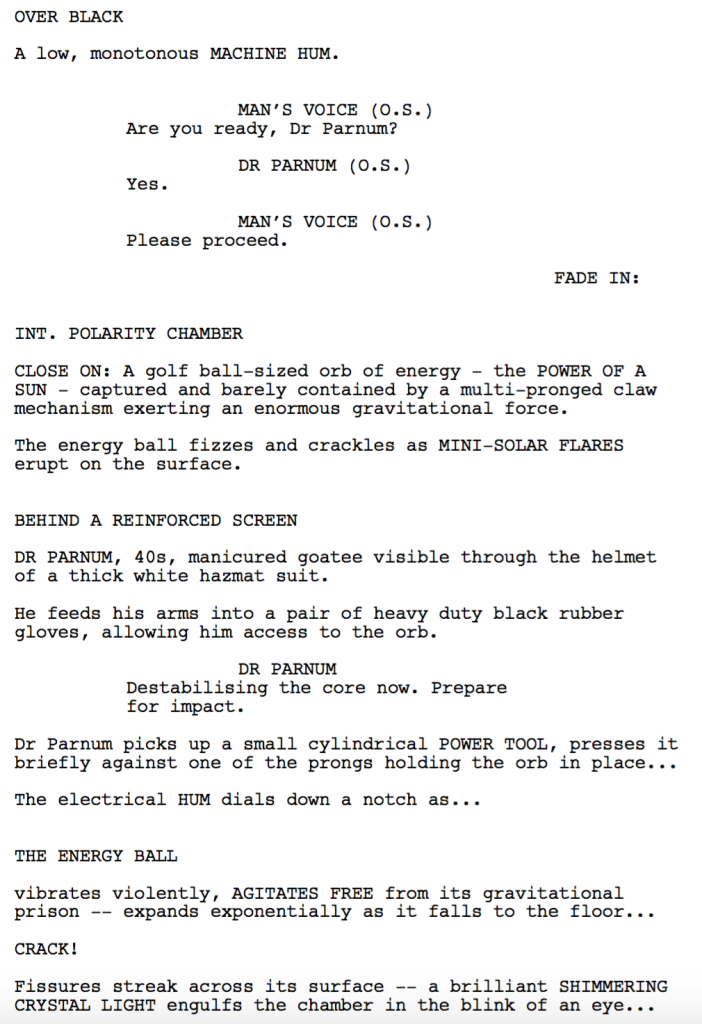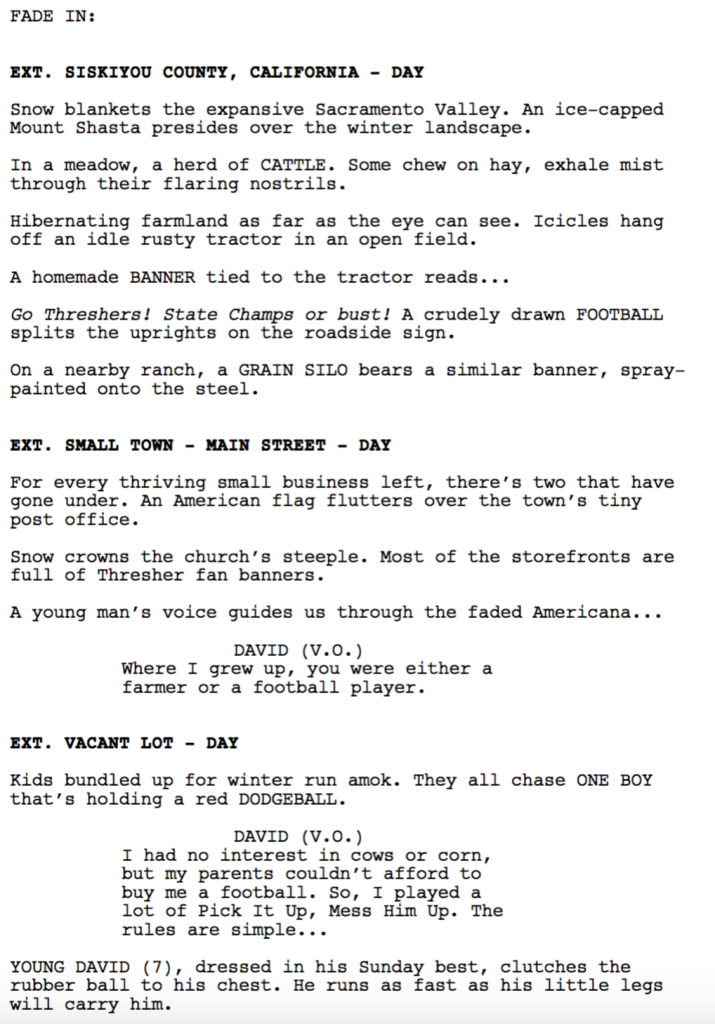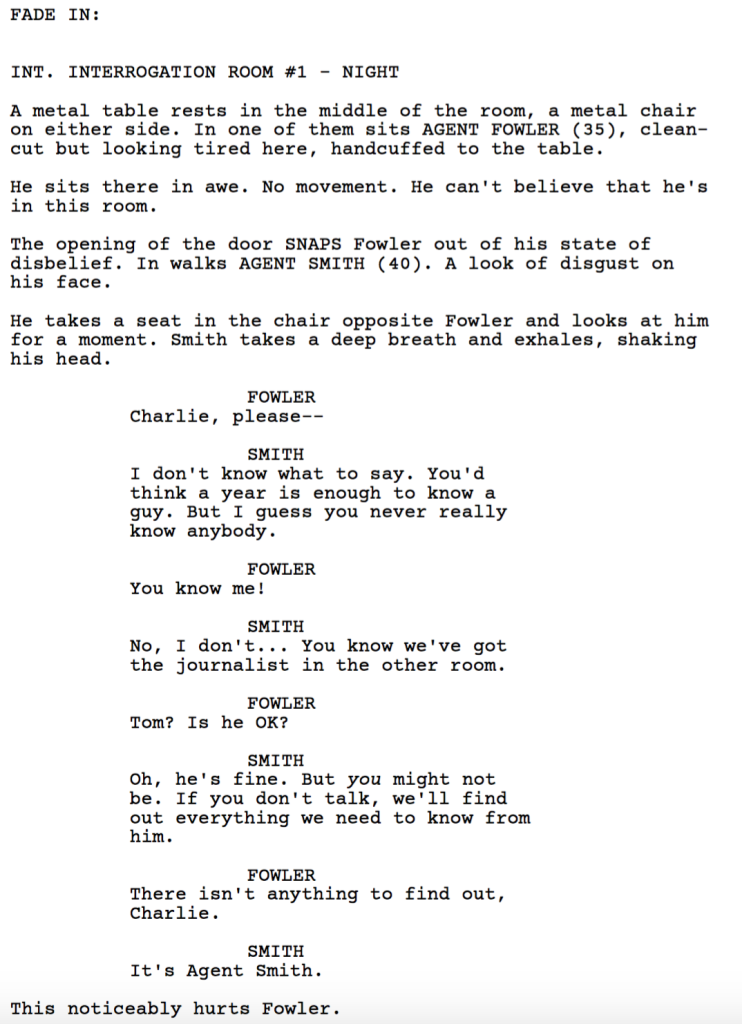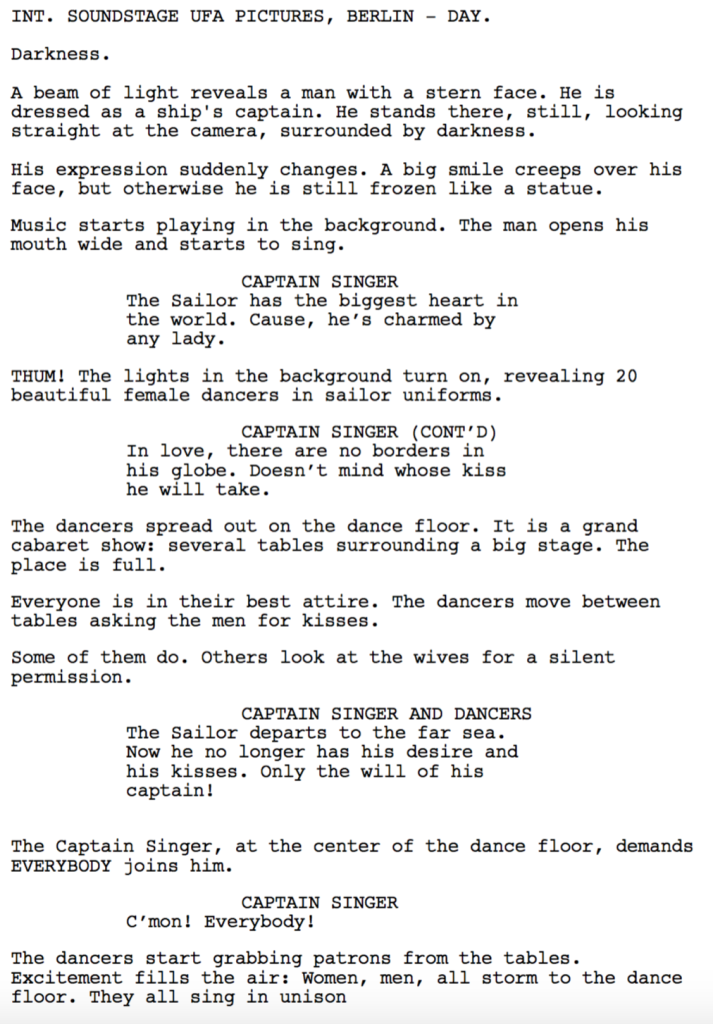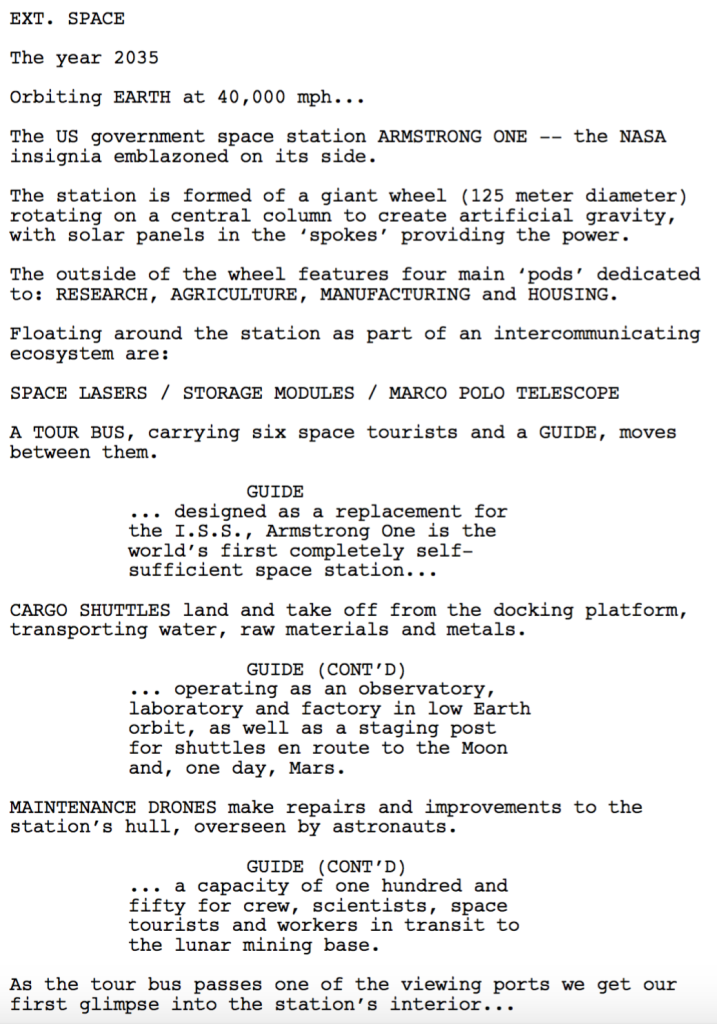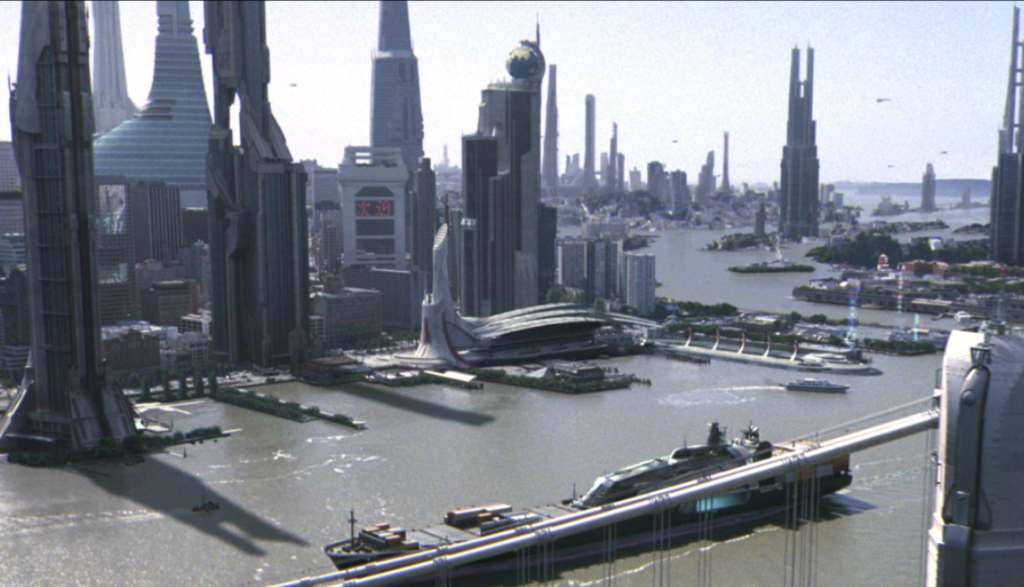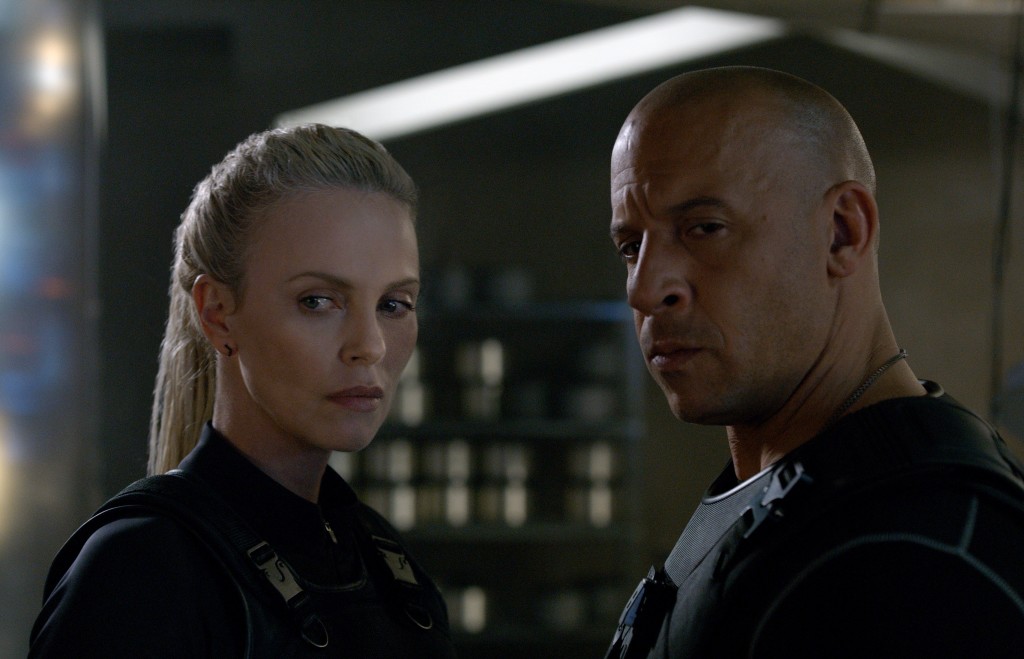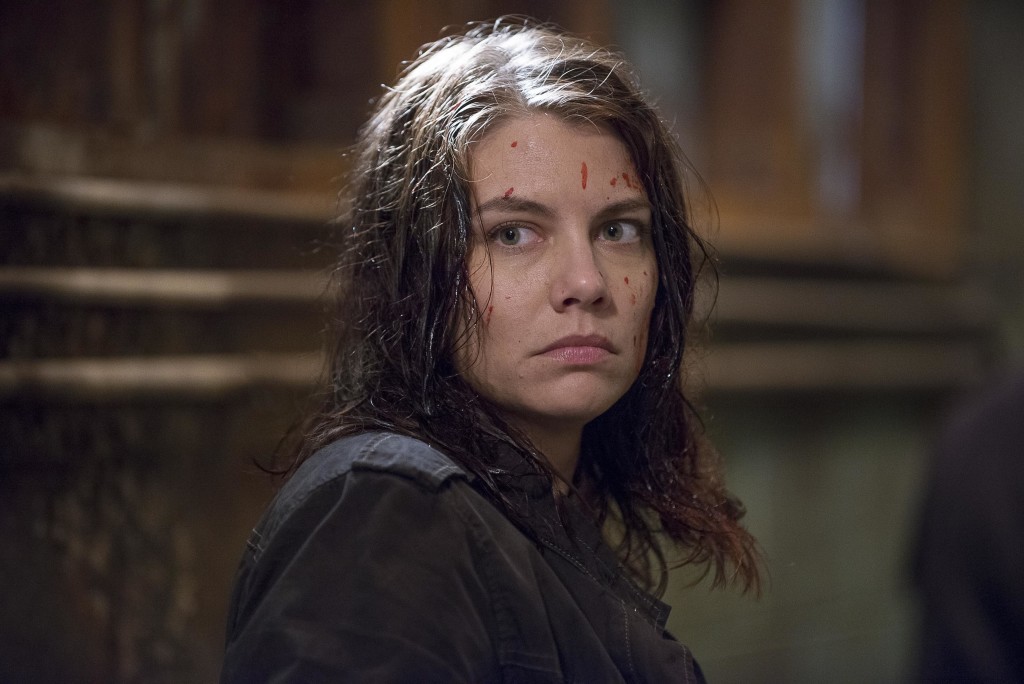Search Results for: scriptshadow 250
Genre: Horror
Premise: A group of geologists in the Amazon stumble upon a fossil of a mysterious hand, and when they go looking for the rest of the body, get more than they bargained for.
About: The birth of an idea! Mexican cinematographer Gabriel Figueroa told producer William Alland about a myth he’d heard of a race of half-fish, half-human creatures in the Amazon. Alland revisited the conversation 10 years later, thinking it would make a good movie. He wrote some story notes, which writer Maurice Zimm would later expand into a treatment. Finally, Harry Essex and Arthur Ross turned the treatment into a full-fledged script. Listen to the people in your life, guys. Ya never know where your next idea might come from. What’s interesting about this film is that it was shot and projected in 3-D. However, the year was 1954, and the 3-D fad was dying quickly (hmmm, why does this sound familiar?). The Creature From The Black Lagoon was a last ditch attempt to save the format. However, it didn’t, and most people ended up seeing the film in regular format.
Writers: Harry Essex and Arthur Ross (story by Maurice Zimm, idea by William Alland)
Details: 79 minutes
When I go through all the old scripts that have been purchased or optioned throughout the years, there are tons that never get made. However, the one genre whose purchased scripts get made the most – BY FAR – is horror. It’s crazy. Almost every old horror script I find on my hard drive has ended up becoming a movie. It’s the friendliest genre to writers out there.
While I continue to look for stuff that hasn’t been made yet, I thought I’d review a horror classic that I hate to admit I’d never seen before. In fact, I was so ignorant of this film that I thought it and “Swamp Thing” were the same movie. I need to work on my water body differentiation. But yes, when I saw this film at the top of Itunes’ Classics list, I thought, “It’s about time for me to check this out.”
For those who haven’t seen “Creature,” it follows fish scientist David Reed and his girlfriend Kay, who go on an expedition into the Amazon with a small crew of scientists to find additional information on a mysterious amphibious hand that David’s old geologist teacher, Dr. Thomas, dug up.
When they get to the dig site, they find that the two men guarding the site have been killed. Hmmm, might a modern-day version of the creature have attacked the men? Meanwhile, David’s getting agitated with one of the crew members, Mark Williams, who only seems to care about money. But since Williams is funding the expedition, David has no choice but to suck it up.
Eventually they realize that the river drifts down into a secluded lagoon, so that’s where they go looking for more fossils. David and Williams do some deep-lagoon diving, where they eventually encounter the creature. At first they want to capture the thing, but when it starts killing their crew members, priorities change. It’s time to jet. There’s only one problem. The creature has lodged a blockade into the only exit. The ship is stuck there. And it’s time for battle.
Wow, the first thing I noticed about this is how much influence it had on Spielberg. You can see a lot of the same shots that Spielberg uses. The creature’s hand, which we see throughout the first act, might as well be a shark fin. And the creature’s attack on the two natives in the tent, seen from outside, with only a bunch of shadows bustling around, had a distinctive “Jurassic Park” feel to it.
You can also see how this influenced James Cameron. I wouldn’t be surprised if he’d used this as a pseudo-template for Aliens, with the financially-motivated Williams a dead-ringer for Paul Reiser’s “Burke.”
But the big question is, does the script hold up after all these years? Yes and no. The first act moves surprisingly fast. Plot points are set up quickly and we’re off to the races without a moment to spare. Of particular interest was a scene where Dr. Thompson picks up Dave from a dive, then shows him a picture of the creature’s hand on the boat ride back to the beach.
The fact that they were combining beats (the ride back to the beach AND intro’ing the fossil to David) is proof that even back in 1954, they were looking for ways to speed the story along. I would’ve imagined that they’d wait to get the character back in a still room with everyone standing around before showing David the picture.
Where the movie runs into trouble is once they start deep-diving into the lagoon to look for the creature. I have to remember that people didn’t have the internet back then. I mean, while I was watching this movie, I was texting, interneting, and doing some work. People just didn’t do that back then. They had all the time in the world. Imagine that for a second. Going to a movie and that was your day. It was what you looked forward to, what you experienced, and what you talked about after. We just don’t do that now.
Anyway, I’m guessing underwater photography was a new toy in 1954 because any time we went underwater, we stayed there forever. How many times can you show a girl swimming and the creature creeping up and barely touching her before swimming away again? According to Creature From the Black Lagoon, a good 8 or 9. Ditto whenever the men go hunting for it. We cut endlessly back and forth between the men and the creature.
I’m guessing 1950s audiences were more tolerant of this because their attention spans were longer. But you can’t get away with that today, and it’s not just for technical reasons. It’s for story reasons. The longer you show something, the more used to it the audience/reader gets. So if you’re going to show us 50 shots of the creature on the first dive, we’re going to get used to him. And the more used to him we are, the less afraid of him we’ll be.
“It” did a nice job of this. When Pennywise comes, he comes in forms other than a clown, he’s hidden behind balloons, we’ll hear him but not see him, he’ll pop up then disappear immediately. Even in the famous opening scene, we’re only seeing his eyes. This is important. If we get used to Pennywise, he won’t be as scary.
Another issue here is that there was zero attention paid to character development. I don’t know if that was common back then, or just common in creature-features. Citizen Kane had some pretty stellar character development and that came out 13 years before this did.
But it really hurts the movie as it goes on. This is important to remember, guys. If all you’re doing is moving the plot along, it’s a bit like moving chess pieces. Things are happening. We’re getting closer to a resolution. But we feel strangely detached, and eventually bored. To keep the chess analogy going, tell us something about the people playing. That’s how you make a chess match truly captivating.
I remember an old girlfriend of mine who HATED basketball. Thought it was so dumb. She’d actually get mad at me whenever I’d watch my beloved Chicago Bulls. “I don’t see why you care so much about a bunch of guys throwing a ball in a hoop,” was a common argument-starter.
Finally, one day, I sat her down. “You don’t understand,” I said. “You see that guy there? He doesn’t believe that our coach is any good. So half the time the coach gives him a play, he ignores it. And you see that guy? He was once the worst guy on the team. But now he’s knocking on the door of being the best. Our best player, that guy with the buzz cut, is feeling that pressure. He’s afraid of being supplanted. So he doesn’t pass that guy the ball. And that guy? Our center? He’s so badly injured that he shouldn’t be playing. But he has to or else he won’t get a contract extension and probably be out of the league next year. If you watch him closely, you can see how much pain he’s in.”
She became fascinated. These weren’t just “guys throwing a ball in a hoop.” These were real people with problems and conflicts and drama! Which equals entertainment! I couldn’t keep her away from watching games with me after that.
Getting back to Lagoon, there wasn’t a more boring relationship in the last 100 movies I saw than David and Kay. It was the single most agreeable couple I’d seen on film (tip: agreeable is a BAD WORD in screenwriting). I guess no one was breaking down walls to write captivating female characters in 1954. Still, this was a major reason why the movie lost steam. We simply didn’t know enough about these people to care about them.
Which leads us to the dialogue. Most of it was written to either move the story forward (“We need to go to the lagoon!”) or to pose theories (“This could be the link between man and fish we’ve been looking for”). You’re going to have to do those things in every script. But dialogue should primarily be used to explore character.
And by that, I don’t mean each character should spout off a 50 line monologue about who they are and what their life philosophy is. I mean you need to create unresolved issues between characters and each dialogue scene should make us feel like we’re getting a little bit closer to resolving the issue.
In another water based movie, Dead Calm, a husband and wife haven’t resolved the death of their child. It’s hanging there in every scene, even if they’re not talking about it. So we know that, eventually, we’re going to get a resolution to that. That’s how you explore character.
Anyway, this was more fun than I thought it would be. But because I live in 2017 and not 1954, there were only so many things I could overlook. Still, it’s worth checking out if you have 80 minutes.
[ ] What the hell did I just watch?
[ ] wasn’t for me
[x] worth the watch
[ ] impressive
[ ] genius
What I learned: Something only stays mysterious if you give us bits and pieces of it. If you give us the whole thing and you keep showing it to us again and again, we’re going to get used to it, and eventually, bored of it. Both filmmakers that I named in this article – Spielberg and Cameron – know that well, as their films Jaws and Aliens do a magnificent job of only showing us bits and pieces of the monsters throughout.
There are no movies coming out this weekend. You know it to be true. Which means one thing. IT’S TIME TO READ SOME SCRIPTS! Will we find the next Das Chimp out of this weekend’s entries? Or the next Orbital (that’s an old-school Scriptshadow joke there)?
How to play: Read as much of each script as you can and submit your winning vote in the comments section. Winner gets a script review next Friday!
If you’d like to submit your own script to compete on Amateur Offerings, send a PDF of your script to carsonreeves3@gmail.com with the title, genre, logline, and why you think your script should get a shot. Good luck!
Title: Radiant City
Genre: Sci-fi
Logline: In a post-apocalyptic city where people have gained the ability to cast ‘echoes’ – temporary copies of themselves – an Echo Crime Detective hunts a killer with the unprecedented ability to echo other people.
Why You Should Read: Radiant City is a noir-tinged sci-fi thriller with inventive set pieces, a racing plot, and a super strong protagonist that will have A-listers clamouring to get their agents on the phone. Well, that’s the dream anyway! Read a word, a page, or the whole thing – all candid feedback is welcome, you lovely people.
Title: THE COMEBACK
Genre: Drama
Logline: An inspiring story based on true events about an all-star high school quarterback that loses his throwing arm, but is determined to return to the game he loves with the help of a retired NFL physical trainer.
Why You Should Read: The script’s inspired by the true story of a one-armed high school quarterback from Seattle. I was so blown away by the kid’s determination, I wrote this tale that’s told in the vein of Soul Surfer and Rudy. Per Carson’s lesson, I said No to my protag as much as I could on his difficult quest of rehabilitation and redemption.
Title: Ridgeville
Genre: Crime Drama
Logline: After the elusive serial killer known as “The Exterminator” is apprehended under mysterious circumstances, an FBI Agent and a local journalist team up to find the real killer.
Why You Should Read: My name is David Fershtadt, and I am going to be a freshman in college this year. When I was in eighth grade, I sprained my ankle during basketball practice. At the time, I wasn’t that big of a movie fan. However, since I couldn’t walk for a few days, I decided to watch some movies. I went to the IMDb top 250 and picked some that I liked. Ever since, I have been a huge movie fan. Since I also love to write, I figured I should try to write a screenplay. I started writing Ridgeville two years ago, but gave up soon after. Recently, since it was the second semester of senior year, I had time to look at what I wrote, see what I could fix, and power through. Now, I have a finished feature length screenplay. I think you should read my script because I believe that it is compelling enough to keep your attention throughout. It will have you asking questions from the start and make you want to find the answers. I also want to be able to get feedback that will help me become a better writer, and I believe you can provide me with that. Thank you so much for your consideration!
Title: The King’s Fool
Genre: Historical/Drama
Logline: During World War 2, a famous Jewish director was coerced by the Nazis to produce a propaganda film showing the concentration camps as a spa for Jews, all while being a prisoner in one. Based on the true story of Kurt Gerron.
Why You Should Read: For the past seven years, I’ve been writing, directing and producing my own short films. Since my love for making movies is bigger than my wallet, I almost went bankrupt because of it. With that said, a year ago I wrote this screenplay after a FULL YEAR of research. The story is full of irony, and I never understood why no one had made a movie about Kurt yet.
Title: Genesis Protocol
Genre: Sci-fi / disaster
Logline: The year 2035. With Earth facing imminent destruction, a government space station — with capacity for only 150 people — becomes the last refuge for what will remain of the human race.
Why You Should Read: I’ve now written over a dozen screenplays but nothing prepared me for a story of this magnitude and complexity. For the first time ever I took on a writing partner — an engineer / scientist specialising in the design of space habitats — to make the script as accurate and authentic as possible. It has been a fantastic experience (for me at least, I can’t speak for him!) and we now have various other ideas brewing including a graphic novel. I hope you guys enjoy the script and thank you in advance for any feedback.
Genre: Sci-Fi Drama?
Premise: (from Black List) An exploration of relationships as a man witnesses different types of love across the ages.
About: This one finished pretty high on last year’s Black List. This is Tom Dean’s breakthrough script.
Writer: Tom Dean
Details: 127 pages
I didn’t make it to Baby Driver this weekend. Maybe I’ll see it tomorrow and do that script-to-screen review for Wednesday. The movie’s doing quite well, which, despite my negative script review, I’m happy about. We need more filmmakers taking chances like Wright.
Speaking of a movie that didn’t take ANY chances, The House was decimated at the box office this weekend. I’m not surprised. It always felt like a lazy idea. Plus, marriage isn’t funny. If you look at the history of comedies, marriage has never been funny.
Then there’s the new Netflix show, GLOW. I don’t know what to make of that one. I’ve watched four episodes and the writing vacillates between really good and really sloppy. The majority of the scenes feel like they were filmed before anyone knew the cameras were rolling. And the main character, played by Alison Brie (the whole reason I tuned in), is inexplicably kept in the background the majority of the time. I haven’t given up on it yet. But episode 5 better be awesome.
Moving on to today’s script, I’m surprised I haven’t reviewed it yet. It’s on the Black List. It’s time-travel. Sounds right up my alley!
The year is 1960. Sort of. This is 1960 after the invention of time-travel. Which means there’s been some changes. Subtle changes. Like futuristic shit stitched in. But changes nonetheless. It’s here where our Narrator, who will take us through the many time periods in the story, introduces himself. He explains that it’s his job to keep lovers properly meeting each other in all the various time periods.
We first get to know Cecile and Sanjay, who live in Napa Valley circa 1820. But, once again, you have to remember that just because we’re in 1820, doesn’t mean that the characters were born in this era. Both Cecile and Sanjay are from different time periods in the future, or at least, some future after 1820. We watch both of them get in a huge fight, and then we cut to New York City, circa 2402.
It’s here where Sanjay is now a young assistant at a giant company. He’s told by his boss, Henri, to deliver a gift to Henri’s wife back at their condo. Once there, however, a 50 year-old Claire, Henri’s wife, discusses happiness and love with Sanjay before ultimately seducing him.
From there, we cut to Nice, France, circa 1930, where we meet Claire as a 25 year-old. She’s just moved here, and a young cop named Antoine knocks on her door to see if she knows anything about a murder that was committed outside. Antoine falls in love with Claire at first sight, but must use his fellow English-speaking cop to translate his love for Claire.
Cut to 40 years earlier, also in Nice, France, where Antoine is now older, or maybe younger, and is now an actor. Antoine is now in love with Roland, a 30 year-old transgender man. The two fight with each other about their future, specifically how Antoine cannot be with a transgender person.
That takes us to about page 70. And I could go on. But I think you get the idea.
The original paragraph that I was going to write here, I deleted. It was too personal, too negative. And I think Dean deserves credit for his ambition. Without ambition, we get Transformers 6. There’s something to be said for artists who stand up to movies like that.
However, I can’t get past how unnecessarily complicated this story is. There’s the time-travel mythology. There’s a complex narrative. There are tons of rules. There’s no true main character. Dialogue scenes go on forever. The fourth wall is broken. It’s over 120 pages. The characters we do get are all over the place.
For example, one character is a transgender man in one time period, and then a woman when we cut to earlier in his life. Except that he’s actually living in a later time period when he’s younger. It’s almost like the writing is done to specifically confuse us rather than entertain us.
At one point, in 1960, when our characters are going to a movie, they see this on the marquee: “George Clooney in ‘11th Avenue’ Directed by Howard Hawks. His first film after time travel.”
There are also a lot of lines like this: “If it happens you’re familiar with 1820’s Napa Valley, this version won’t look familiar at all. The architecture is limited to the style and technology of early 19th century, but it is very much lived in, developed, and flourishing.”
And then we get dialogue like this: “Okay. Well, when we travel through time, we regulate exactly what dimension it is we travel inside of. That’s why when you travel from 2500 to 1500, you don’t alter the past and create a paradox that would essentially change the course of events so that your parents would never meet and thus never have you and thus never afford you the opportunity to change the past in the first place.”
When you’re reading stuff like this while attempting to follow characters backwards through time, those characters sometimes getting older despite the year being before or getting younger despite the year being after, it gets to a point where you throw up your hands. You’re rooting for scripts that take chances. But if we’re not even sure what’s going on, how can you root?
To the screenplay’s credit, it starts to come together in the end. There was a moment where I thought, “Wow, this reminds me a lot of when I first read Eternal Sunshine of the Spotless Mind.” But whereas it was always clear in that screenplay what was going on, this one you’re in the dark the majority of the time.
The thing is, there’s a good idea in here somewhere – this concept of following love stories backwards in time. Going in reverse from each relationship to the characters’ previous relationships, and taking that further and further back until you get to the first person who started the chain. But instead we have this time travel stuff which you need Neil Degrasse Tyson next to you to explain.
So what’s the lesson here? I’m not sure. Shouldn’t new writers be taking chances like this? Isn’t ignorance, in a way, an advantage? Christopher McQuarrie stated that his best script, the one that got him an Oscar, The Usual Suspects, was written with barely any screenwriting knowledge. He said that he wouldn’t have done a lot of the inventive stuff he did had he known then what he knows now.
So why beat Dean up for that? This comes back to one of my weaknesses as an analyst, which is my defiance of experimentation. But I think my issue here is a valid one. Had their been one experimental choice, I would’ve been okay. My problem with La Ronde is that there were half-a-dozen experimental choices stacked on top of each other. And screenplays just aren’t built for that. You can get away with it in novels. Cloud Atlas comes to mind. But screenplays are limited in the types of stories you can tell with them. That’s why this didn’t work for me.
[ ] What the hell did I just read?
[x] wasn’t for me
[ ] worth the read
[ ] impressive
[ ] genius
What I learned: If you’re going to write long scenes, make sure there’s enough tension to sustain them. If there isn’t, we won’t have enough patience to follow the scene through. So there’s a scene in La Ronde where Sanjay brings a gift to his boss’s wife, Claire. He is supposed to slip the gift in the condo and then leave. It is imperative he not get caught. But the extremely lonely Claire catches him, then asks him to have a drink with her. And they start talking. And then there’s more talking. And then there’s more talking. The talking goes on for a really long time. And because of all that talking that’s going nowhere, the scene loses steam. If you’re going to write long dialogue scenes like this, you need to look for ways to keep the tension. For example, what we could’ve done is had Sanjay’s boss tell him he had to be back within 30 minutes, which is barely enough time to complete the task. Then, when Claire catches him, she tells him, “Don’t worry, I won’t tell on you. If you have a drink with me.” Now Sanjay’s stuck between a rock and a hard place. He has to get back to his boss ASAP. And he has to somehow get Claire to let him leave without ratting on him. Without tension, long dialogue scenes die a sad pitiful death. If you watch any of the master’s long dialogue scenes (Tarantino) you’ll see that all of the best ones are laced with tension. And the few that aren’t, are tension-less.
Today we’re going to talk about summer madness and all the shapes, colors, and sizes it comes in. With Fast and the Furious dropping their bi-annual supercharged nonsensical treatise of loyalty and family on an all-too-eager public this weekend, how could you NOT get excited about the summer box office? I know I am. For both the good and the bad. Here are the key projects I’ll be keeping an eye on…
Dunkirk
It’s hard to have much of an opinion on a Christopher Nolan movie before it’s released since he’s so darn secretive. But even the most hardened Nolan films will agree that this is a pivotal movie for Nolan. His last two movies (The Dark Knight Rises and Interstellar) were major messes, with progressively sloppier screenplays. Exploring another genre was a good idea. But now we’re getting details on the plot, which involves soldiers… running away? Hmmm… that doesn’t sound very active or heroic to me. I’ll see any Christopher Nolan movie. They’re events. But if this doesn’t work, the Nolan shrine may need to be placed in storage.
Thor: Ragnarok
Wow. Where the hell did this movie come from?! As if Marvel didn’t have enough success. They take their worst character, pair him with the Hulk, put him back where he came from (another planet) and all of a sudden this looks like the freshest coolest comic book movie out there. There’s a screenwriting lesson to be learned here. You need to play with ideas more when you come up with a concept. If you go the obvious route, you come up with Thor 1 & 2. They found the right combination of ideas with this one and, out of nowhere, it’s awesome. This is now one of my most anticipated movies!
King Arthur
This movie was supposedly shot, then reshot, then one half of that reshoot was reshot and then someone shot themselves for shooting it in the first place. You can tell when a studio movie had extensive reshoots cause that money then comes out of the special effects budget. I suspect the effects to King Arthur were outsourced to a guy in Korea with an Atari 2600. You know a movie is bad when you don’t even know what it’s about after the trailer. What is this about? I suppose they should get credit for giving us a fresh take on King Arthur. But it just goes to show that fresh takes are still gambles. You have one that worked out (Thor) and one that didn’t (King Arthur). It’s time to put that sword back in the rock.
It
If you’re anything like me, you’re skeptical about this new Hollywood benchmark that’s taken over the internet: Most trailer views in 24 hours. It seems to be the only thing that anybody cares about anymore. However, everyone knows that the studios pay for at least a portion of these views. So how seriously can we take them? “It” is the new record holder, with something like 250 million views. Regardless of my trailer view skepticism, the movie looks great, and their adaptation approach was very clever. This book can’t fit into a single movie. However, a trilogy would’ve been too much. To split it into the kids film and the adults film was a stroke of genius. And we all know how much I loved Andres Muscietti’s previous effort, Mama. So count me in!
Guardians 2
There is no franchise more tuned into what the public is looking for than this one. Guardians 2 has just the right blend of character, humor, action and Groot. And you can already tell that this film is more confident than its predecessor, a movie where director James Gunn admitted that he thought he might be making the next Pluto Nash. Guardians will probably win the summer box office prize, a prize it will, unfortunately, have to hand over to Star Wars at the end of the year.
Spiderman: Homecoming
I’m neutral on this one. It seems to me like they’re making a smart play though. You know that old saying, “When you try to please everybody, you please nobody?” That’s clearly what was going on in the last two Spiderman movies. They wanted so badly for everybody to like them that you could feel it permeating off the screen. With this new version, they’ve kinda said, “Let’s move away from that” and gone back to Spiderman’s roots, which are in high school. So they’re targeting a more specific demographic, the teenage crowd, and we’ll see how it works. I know I liked Cop Car (the director of that tiny film landed this job). And if there’s a lesson to be learned for screenwriters, that may be it. Make a small passion project and direct it yourself. Who the hell knows what might come of it?
The Fate of the Furious
I don’t care what you say about Fast and the Furious. It still has the best and most inventive set pieces in the action game. It beats out Mission Impossible, Bourne, and James Bond in that category. In fact, one of the most common notes I give on action specs is to be more inventive with your set pieces. Fast and the Furious had two cars dragging an apartment sized vault through the city streets. You need to do better with your set pieces if you want to compete. Now regarding this plot point of Dominic turning on his team. How probable is it that it’s part of a bigger plan to help his team? One thousand percent? One million?
Valerian
For super movie nerds, this is a project all of us have been following for awhile. Why? One answer: The Fifth Element. This was going to be what Luc Besson would’ve done with The Fifth Element had he had more money. Besson is a great filmmaker. And he was supposedly creating sequences and techniques that had never been used before to give the audience a one-of-a-kind experience with Valerian. But after seeing the trailer, I was shockingly disappointed. This was it?? Sure, it seemed okay. But it hardly felt like something I’ve never seen before. Then it struck me. It wasn’t the visuals I was having a negative reaction to. It was the characters. How fucking boring do these two characters look? They mumble. They have no chemistry. There doesn’t seem to be any conflict between them (in fact, it’s the opposite, they seem to like each other – major screenwriting mistake!). Watch the Guardians and Thor trailers then watch this. Note how much more personality the characters have in those trailers. Valerian is in trouble. And let this be a lesson to screenwriters everywhere. Don’t get lost in your world-building. Make sure the characters are compelling first. Or nothing else matters.
Alien: Covenant
Why do I get the feeling that Scott’s only making these movies out of spite? And when Scott goes spite, he goes FULL SPITE! After this film, he has three more Alien movies lined up. Say what?? Not to jump on Thor’s jock yet again. But the idea with any franchise is to elevate, find fresh new ways to explore the subject matter. This looks like the same exact movie as the last one. I don’t get it.
Rest of the movies: I’m not a fan of the DC films so I’m not looking forward to Justice League or Wonder Woman. It seems that their big mistake is hiring visual directors, whereas the Marvel guys are hiring storytellers. As for “maybe” movies – Pirates, The Mummy, and Apes – the reinvigorated Pirates looks like it’ll be the breakout (can Disney do no wrong?). But The Mummy doesn’t look bad either. Don’t get me started on Transformers (they could slip one of the previous four films in theaters, slap a “5” on it, and I swear nobody would notice. Save 200 million bucks). One day somebody’s going to do a documentary on how the five worst movies ever made became five of the biggest box offices successes of all time. Of the two Stephen King offerings, The Dark Tower was never my cup of tea. “It” was so inspired. Tower just dragged on. I never made it to the end (8 books!), but I hear the ending was terrible. All that investment for no payoff. I have a feeling this franchise isn’t going work. Still, one for two ain’t bad.
And that’s my roundup! What about you folks? What are you looking forward to? What movies do you think are undervalued? Overvalued? Chime in in the comments!
Today I review the coolest TV premise I’ve come across all year!
Genre: TV Pilot – Sci-fi/Drama
Premise: A small American town on the east coast finds itself dealing with a group of refugees… from the future.
About: Whereas yesterday’s writer was a neophyte, today’s writers – Dan Dwarkin & Jay Beattie – are anything but. These guys have been writing TV forever. They’ve worked on Vanished, Criminal Minds, The Event, Revenge, Matador, Scorpion, Cold Case. They sold this show to ABC this past offseason, which, if it hits, I think will be their first created show. But maybe someone will correct me on that.
Writer: Dan Dworkin & Jay Beattie
Details: 63 pages
Every once in awhile a concept comes along where you’re like, “Wow.”
Here’s how you create such a concept. First, you come up with a cool idea. That by itself is hard to do. But then, in addition to it being a cool idea, you must also make it timely. Now you’re merging two individual things that get audiences interested in a show into one giant super-premise.
Whenever I see such an idea, I don’t get excited. I get nervous. Cause I’m like, “You’ve just achieved something that only happens a few times a year. Please… DON’T SCREW IT UP.”
And with that optimistic attitude, let’s jump into today’s pilot, shall we!?
Port Canaan is a small East Coast fishing town that’s about to become the center of one hell of a mystery. Hundreds of bodies come floating up to the surface of the ocean. Most of them are dead. But some are clinging to life.
The locals spring into action, led by the new sheriff, Jude, a former Philly cop who let booze destroy his life. He’s now got a kid his wife won’t even let him talk to. When Jude realizes just how big this thing is, he calls in the Coast Guard. And from there, it isn’t long before the FBI flies in.
Enter agent Emma Peralta, the kind of woman who’s seen enough not to get rattled by much, even something as bizarre as this. When Peralta questions where these people are from, they tell her, “America.” Where in America, she asks. Not where, they tell her. When. They’re from an America 250 years in the future.
Peralta believes that as much as she believes they’re cancelling taxes this year. But there is something odd about these people. Enough to call in some bigger guns. And when those guns arrive, loaded and ready, they strangely can’t find any cracks in the refugees’ story. When you add on that no ship or plane wreckage was found, they’re forced to face the unthinkable. What if they’re telling the truth?
Meanwhile, one of the time jumping refugees, an athletic sniper of a woman with the perfect futuristic name – Rae – finds her way onto shore before the FBI spot her. She runs into Jude and tells him she needs him. For what, he asks. Well, that’s something we find out from another jumper. You see, according to these guys, they weren’t the first to jump. In fact, there are more people from the future here than we realize.
There’s something to be said for craft.
I’ve gotten to a stage in my reading where when you don’t tell me anything about a script, I can tell whether it was written by a new guy on the block, a guy who’s almost there, a guy who’s written a few professional scripts, or writers like these guys, who’ve worked in the business forever. Before I did research on this script, I could just tell that these two knew what the hell they were doing.
The pros have an effortless ability to drift between lots of character storylines (common in TV), yet keep the plot focused and moving. Newbies, meanwhile, will jump around with more of a reckless abandon, or worse, they’ll jump around for the sake of jumping around.
They won’t actually use the scenes to move the story forward. Many times in newbie scripts, scenes won’t even have a point. They’ll be there simply because the writer knew he had to write a scene.
Think about that for a moment. You should never write a scene just because you know you have to put something there. Every scene needs to have a purpose, to have a point. Think of it this way. Treat your scenes like your script. You have a passion for writing your script, don’t you? Well bring that same passion into writing each individual scene and make those scenes as compelling and entertaining as you can possibly make them.
(If you don’t know how to write a scene, check out my recent article on them).
That leads me to today’s hot screenwriting tip: controlled mess.
Writers tend to go one of two ways when they write. The first is uncontrolled mess. This is when the writer doesn’t have a plan, a theme, any definitive characters goals. Their script goes wherever their mind takes them in the moment, leading to a messy and, ultimately, random story.
The second is a mistake that intermediate screenwriters make. I call it, controlled order. Here, the writer goes in the opposite direction. They know structure and character development so well that everything is focused, goal-oriented, and clean. Which sounds good. But the problem with controlled order is that it’s TOO CLEAN. Everything is so in-line, so perfect, that the story is obvious, predictable, and lifeless. You’re following the letter of the law and therefore you never surprise us.
What you want is option 3: Controlled mess.
This combines the best of both worlds. You get the messiness that keeps your story exciting and unpredictable. But it’s a calculated mess. The writer’s mastery of craft allows him to control it, keeping the story purposeful at all times.
If that’s confusing, I’ll give you an example from this script. When all the refugees show up, the writers have them operate as a giant group. They’re lumped in together. Emma, the agent, comes in every once in awhile to ask them questions. It’s very much “controlled order.”
However, the writers also introduce a rogue character, Rae, who the rescuers didn’t spot. Rae gets to shore separately, moves into town, and starts wreaking havoc. This is the “mess” part. By “messing up” the integration of the refugees, the writers give you a more unpredictable story. What was once clean now feels untamed.
With your own scripts, figure out which side of the fence you’re on. Are you on the uncontrolled mess or controlled order side? From there, you can figure out what you need more of to get to controlled mess.
As for the rest of this script, I thought it was great. This pilot could work as a classroom for TV writing. Not only was the pilot itself first-class writing, but it implies such a bigger world in the coming episodes. This feels to me like ABC is trying to get back into the “Lost” business. I hope they get the production part right cause this is a show I would watch.
[ ] What the hell did I just read?
[ ] wasn’t for me
[ ] worth the read
[x] impressive
[ ] genius
What I learned: I’m a big advocate of messing up your story a bit. As much as some of you think I’m a stickler for the rules, I’m actually not. I’m only a stickler for the core rules that have been the foundation of storytelling for hundreds of years. I hate when scripts are technically perfect. That’s where I’d place yesterday’s script – Hummingbird. It was technically perfectly executed. But that was the problem. There was no mess. It followed all the beats just like you’re supposed to. I might as well have read a screenwriting book. So add the mess, guys. Just make sure it’s controlled mess. :)

